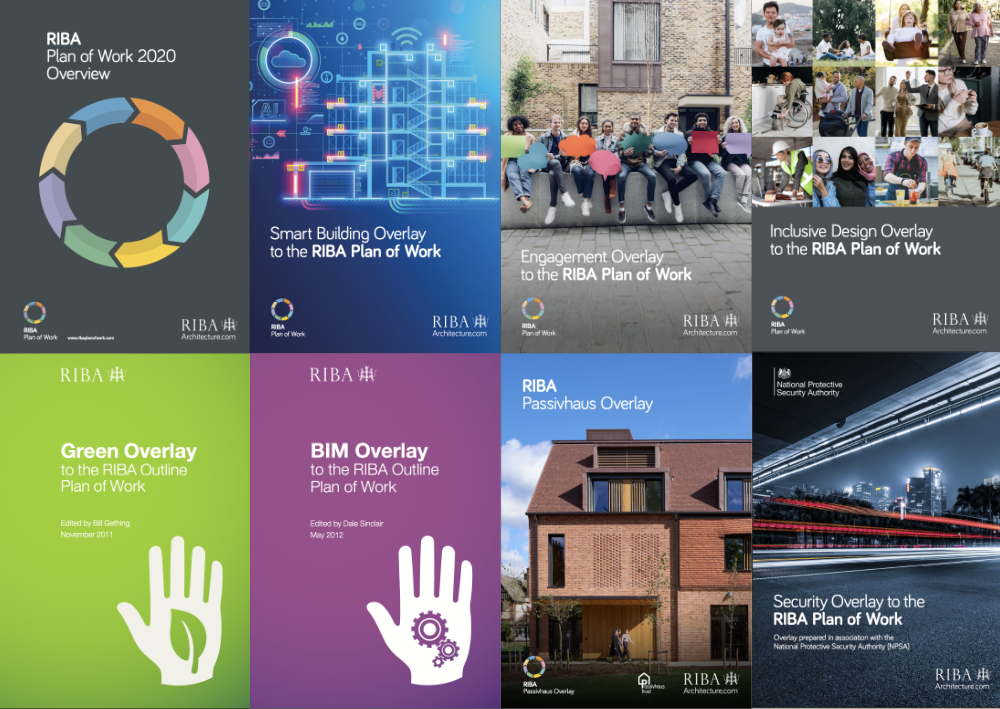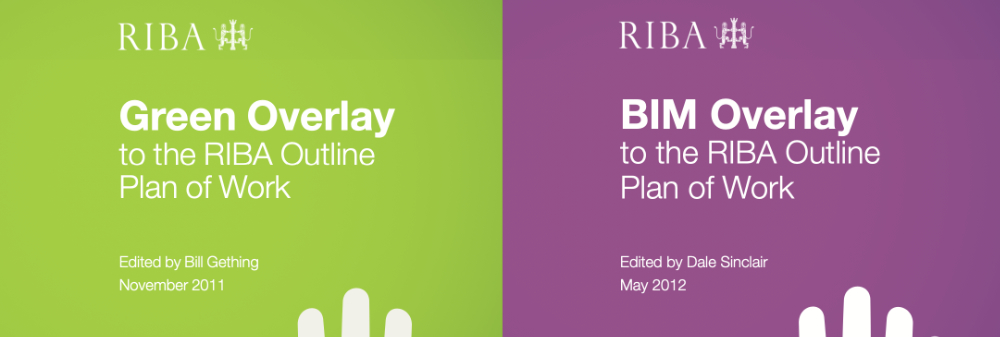Overlays to the RIBA plan of work
The RIBA Plan of Work is published by the Royal Institute of British Architects (RIBA). Its latest version is also endorsed by the Chartered Institute of Architectural Technologists, the Construction Industry Council, the Royal Incorporation of Architects in Scotland, the Royal Society of Architects in Wales, and the Royal Society of Ulster Architects.
Contents |
[edit] Background to the plan of work
The Plan of Work was originally launched in 1963 as a fold-out sheet that illustrated the roles of participants in design and construction in a simple matrix format. Since then it has always been divided into a number of project stages and provides a shared framework for design and construction that offers both a process map and a management tool. While projects may not always follow the details of the plan, the stages are used as a means of organising tasks and communicating them, as well as designating stage payments and identifying responsibilities, and often appear in contracts and appointment documents.
The Plan of Work has evolved through its history to reflect the increasing complexity of projects, to incorporate increasing and changing regulatory requirements, and to reflect the demands of industry and government research. It has moved from a simple matrix representing the traditional procurement route to include multiple procurement routes, more diverse roles, multi-disciplinary teams, government gateways, and stages that take place before and after design and construction.
It has however received criticism in the past for changing names, definitions, and terms of reference for project stages, its focus on the role of the architect and lack of detail in the stages prior to appointment, as well a lack of coordination with other industry project plans. This can leave clients and other stakeholders confused about what terminology is being used and what it refers to.
[edit] Current RIBA work stages
The latest version of the RIBA plan of work was published in 2020 when the work stages were re-structured and re-named.
- 0 - Strategic definition.
- 1 - Preparation and briefing.
- 2 - Concept design.
- 3 - Spatial coordination.
- 4 - Technical design.
- 5 - Manufacturing and construction.
- 6 - Handover.
- 7 - Use.
[edit] Background to the overlays
Overlays to the RIBA Plan of Work are intended as professional guidance in certain focus areas relative to the stages of work. The first overlay was published in 2011 - the Green Overlay. The Green Overlay, no longer available on the RIBA website, was edited by Bill Gething and included sustainability checkpoints that were relevant to the RIBA Outline Plan of Work 2007. It also aligned with and recommended the adoption of the Soft Landings Framework, including project appraisal, handover, and post-completion activities.
In 2012, the BIM overlay to the RIBA Outline Plan of Work 2007 highlighted the fact that 2D computer-aided design (CAD) processes had developed without Common Standards being adopted throughout the industry. The varying CAD manuals and standards in use by different practices made it difficult for designers to move seamlessly from one project team to another. To ensure that the new emerging standards relating to BIM gain proper traction across the industry, clear guidance was essential.
The RIBA Plan of Work 2013 included multi-disciplinary schedules of services and a number of supporting documents to act either as appendices to RIBA Agreements and/or as appendices for bespoke forms of appointment.
[edit] RIBA overlays today
A number of overlays have now been published by the RIBA to provide detailed guidance on specific design and built environment considerations. Not all previous overlays are available via the RIBA but the following overlays continue to be available. There are also other publications that make reference to the RIBA overlay as the basis of their work, however these are generally not officially approved RIBA publications, some of these are also, beneath the RIBA publications.
[edit] Design for Manufacture and Assembly Overlay
Design for Manufacture and Assembly (DfMA) Overlay (November, 2021) Was first published in 2016 as a project management guide when implementing modern methods of construction (MMC) the latest edition is based on five years of evolution.
[edit] Passivhaus Overlay
The Passivhaus Overlay (February, 2023) was jointly commissioned by the Passivhaus Trust and the RIBA . It sets out key actions and processes needed at each work stage for clients and project teams wishing to deliver Passivhaus certified projects. It outlines key differences between Passivhaus workflows and 'conventional' project approaches, and aims to help clients and project teams avoid risk and make informed, intelligent decisions at the right time to achieve streamlined and cost effective certification.
[edit] Security Overlay
The Security Overlay (April, 2023) was developed by the National Protective Security Authority (NPSA), RIBA and Police Crime Prevention Initiatives (CPI). It is intended for those involved in the safe and secure design, construction and operation of any building.
[edit] Inclusive Design Overlay
The Inclusive Design Overlay (July, 2023) is a collaborative piece of work, with contributions from over 100 professionals across 25 built environment professions, offering insight and best practice into inclusive design. It was developed with reference to the Inclusion Charter, which commits the RIBA ‘to embedding inclusive design in all projects, contributing to the development of inclusive environments’.
[edit] Engagement Overlay
The Engagement Overlay (January, 2024) provides a standardised approach and baseline for architects and other built environment professionals to enhance the quality of engagement with all stakeholders and to create capacity for public participation beyond traditional methods of solely informing and consulting. It aims to provide the mechanisms and structure for facilitating early, effective and proportionate engagement throughout all work stages.
[edit] Smart Building Overlay
The Smart Building Overlay (February 2024) was developed to prompt discussions about smart building technology at each work stage and to support timely decisions so that project aspirations articulated at the outset are delivered at completion. It encourages users to consider how technology might support their desired project outcomes and helps them define ‘how smart’ they want their project to be.
[edit] Unofficial RIBA overlays
These overlays make reference to the term overlay as the basis of or tie principles back to the RIBA project project stages. In general these are not official RIBA publications, they maybe in turn not be officially approved by the RIBA, but also not prevented from being published. Some examples of these types of overlay are given below.
[edit] LETI Embodied Carbon Primer
The LETI Embodied Carbon Primer; Supplementary guidance to the Climate Emergency Design Guide is represents LETI’s understanding of how designers need to be designing to meet the climate change targets in 2020. It is intended the primer will evolve over time, reflecting changes in carbon budgets, technologies and the capability of industry. It outlines in detail the magnitude and challenges and the approach taken by LETI to establish guidance. It also summarises the actions to be taken at each RIBA design stage as well as the requirements of four key UK building archetypes in relation to embodied carbon reductions. For further information visit download site here.
[edit] ACAN Circular Economy Design Guide
Circular Economy Design Guide and plan of works that follows the RIBA Work stages was publish January 2024. Split out to Retrofit , Reuse and Newbuild, and each runs through three fundamental circular economy principles: Maximise Reuse, Design for Optimisation, and Minimise Impact and Waste. For further information visit download site here.
[edit] UK Architects Declare Regenerative Design Primer
This document remains a work in progress to review, revise and expand it, using feedback. The Primer is structured around practical suggestions for those working through RIBA’s Work Stages. Part of the wider transition will eventually involve change in the RIBA Plan of Work itself, currently operating in the current system, being alive to regenerative opportunities within the Work Stages to help on the journey towards a regenerative mindset.
- Making the principles of regenerative design accessible;
- Enabling a common language, better communications and project outcomes;
- Providing practical steps and tools for implementation and delivery;
- Illustrating some of the traits of regenerative design;
- Building confidence for everyone to embrace a different way of shaping the built environment.
For further information visit download site here.
[edit] Related articles on Designing Buildings
- BIM outline plan of work.
- Comparison of BIM work stages.
- Comparison of work stages.
- Digital plan of work.
- Designing Buildings Wiki project plans.
- Governance for Railway Investment Projects (GRIP).
- OGC gateway review.
- Plan of work
- Project lifecycle for major road projects.
- RIBA Plan of Work for Fire Safety.
- RIBA plan of work v project plans v OGC gateways.
- RIBA.
- RIBA plan of work.
- The construction playbook.
Featured articles and news
RTPI leader to become new CIOB Chief Executive Officer
Dr Victoria Hills MRTPI, FICE to take over after Caroline Gumble’s departure.
Social and affordable housing, a long term plan for delivery
The “Delivering a Decade of Renewal for Social and Affordable Housing” strategy sets out future path.
A change to adoptive architecture
Effects of global weather warming on architectural detailing, material choice and human interaction.
The proposed publicly owned and backed subsidiary of Homes England, to facilitate new homes.
How big is the problem and what can we do to mitigate the effects?
Overheating guidance and tools for building designers
A number of cool guides to help with the heat.
The UK's Modern Industrial Strategy: A 10 year plan
Previous consultation criticism, current key elements and general support with some persisting reservations.
Building Safety Regulator reforms
New roles, new staff and a new fast track service pave the way for a single construction regulator.
Architectural Technologist CPDs and Communications
CIAT CPD… and how you can do it!
Cooling centres and cool spaces
Managing extreme heat in cities by directing the public to places for heat stress relief and water sources.
Winter gardens: A brief history and warm variations
Extending the season with glass in different forms and terms.
Restoring Great Yarmouth's Winter Gardens
Transforming one of the least sustainable constructions imaginable.
Construction Skills Mission Board launch sector drive
Newly formed government and industry collaboration set strategy for recruiting an additional 100,000 construction workers a year.
New Architects Code comes into effect in September 2025
ARB Architects Code of Conduct and Practice available with ongoing consultation regarding guidance.
Welsh Skills Body (Medr) launches ambitious plan
The new skills body brings together funding and regulation of tertiary education and research for the devolved nation.
Paul Gandy FCIOB announced as next CIOB President
Former Tilbury Douglas CEO takes helm.
UK Infrastructure: A 10 Year Strategy. In brief with reactions
With the National Infrastructure and Service Transformation Authority (NISTA).


























